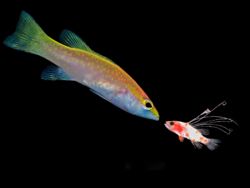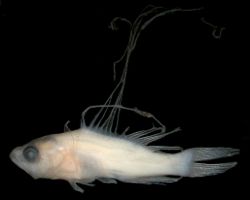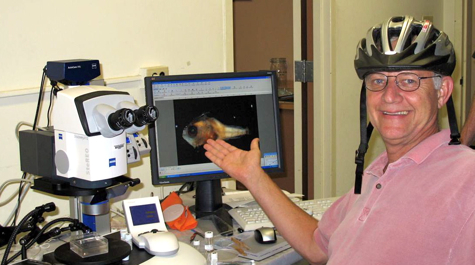Smithsonian scientists honor late VIMS professor with species name
Naming of Liopropoma olneyi a 'nice little fish story'
There is perhaps no higher tribute for a biologist than to have a species named in your honor. John Olney received that recognition posthumously last week when two Smithsonian scientists published a paper naming a new species of sea bass after the late Virginia Institute of Marine Science fisheries professor.
Olney, who died in 2010 at age 62 after a yearlong battle with cancer, had a special fascination with the larvae of marine fishes. That makes the story behind the discovery and designation of his namesake fish particularly fitting.
 Study co-author Carole Baldwin, an alumna of William & Mary's Virginia Institue of Marine Science and zoologist at the Smithsonian’s National Museum of Natural History, says, “We were able to link adults of the new species to an intriguing larval fish caught in the Florida Straits, a ‘little fish story’ that John would have loved.”
Study co-author Carole Baldwin, an alumna of William & Mary's Virginia Institue of Marine Science and zoologist at the Smithsonian’s National Museum of Natural History, says, “We were able to link adults of the new species to an intriguing larval fish caught in the Florida Straits, a ‘little fish story’ that John would have loved.”
Most marine fishes have a pelagic larval stage that drifts in the surface or near-surface currents of the ocean―an environment very different from the one they inhabit as adults. Two different environments often require two different body shapes and appearances, resulting in larvae that look very different from the adults of the same species. That fact makes identification of larval stages of marine fishes in the open ocean very difficult.
 The larva at the center of the study by Baldwin and fellow Smithsonian zoologist David Johnson first came to their attention from a photograph without identification in another research paper. The pair recognized it as a member of the sea bass family Serranidae but were intrigued by its seven very elongate dorsal-fin spines.
The larva at the center of the study by Baldwin and fellow Smithsonian zoologist David Johnson first came to their attention from a photograph without identification in another research paper. The pair recognized it as a member of the sea bass family Serranidae but were intrigued by its seven very elongate dorsal-fin spines.
“This feature isn’t known in any Atlantic sea bass larvae, but it is similar to one species of Indo-Pacific sea bass,” said Johnson. “We initially thought the larva must have been caught in the Indo-Pacific Ocean, but we were wrong.” The fish larva in the photo was in fact caught in the Florida Straits.
The team obtained the preserved larval fish for further study and were met with an immediate mystery—a DNA sequence from the specimen did not match any known fish species. That, along with unique morphological features, led the scientists to begin describing the larva as a new species despite the absence of adults. n another VIMS connection to the story, one of the larval specimens used to formally describe the new species came from the larval-fish collection at VIMS, which Olney was instrumental in developing throughout his 36-year career.
 Meanwhile, in a separate project, Smithsonian scientists were using a manned submersible to explore the deep-reef fish species off of Curaçao in the southern Caribbean. Among the fish collected were “golden basses,” which the team identified as Liopropoma aberrans based on general color pattern; however, genetic analyses revealed more than one species. Combining this new genetic information with available DNA barcoding data for all western Atlantic sea bass specimens yielded an unexpected discovery: The larva from the Florida Straits is the pelagic stage of a cryptic new species of Liopropoma from southern Caribbean deep reefs. The mystery was solved, and a new species of sea bass—now known as Liopropoma olneyi—was discovered.
Meanwhile, in a separate project, Smithsonian scientists were using a manned submersible to explore the deep-reef fish species off of Curaçao in the southern Caribbean. Among the fish collected were “golden basses,” which the team identified as Liopropoma aberrans based on general color pattern; however, genetic analyses revealed more than one species. Combining this new genetic information with available DNA barcoding data for all western Atlantic sea bass specimens yielded an unexpected discovery: The larva from the Florida Straits is the pelagic stage of a cryptic new species of Liopropoma from southern Caribbean deep reefs. The mystery was solved, and a new species of sea bass—now known as Liopropoma olneyi—was discovered.
“This was one of those cases where all the stars were properly aligned,” says Baldwin. “We discover a new species of sea bass on Curaçao deep reefs that just happens to be the missing adult stage of a larval fish from Florida, which we only knew existed because it was included as ‘decoration’ in a scientific publication.”
The full research paper was published in the May 13 issue of PLOS ONE.
 Skip to main content
Skip to main content


